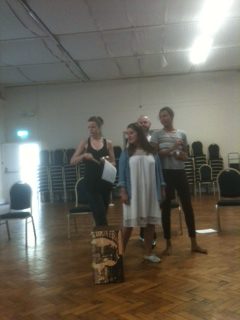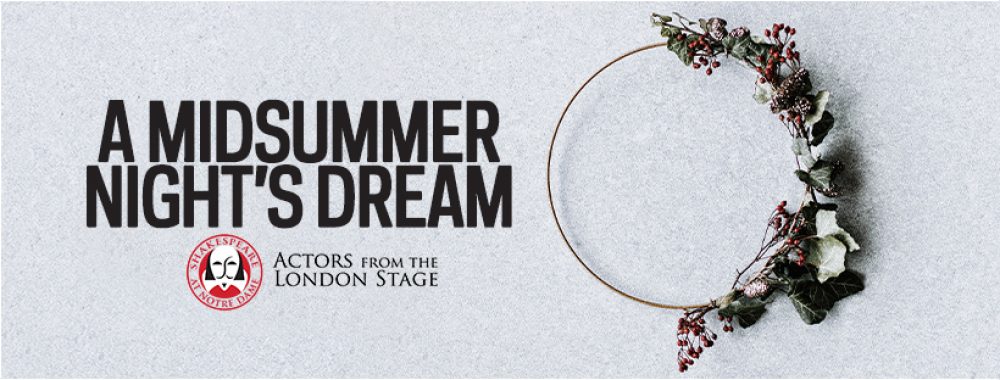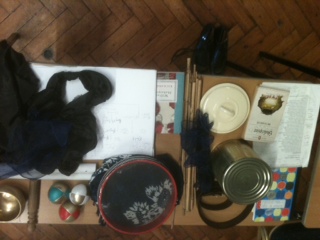We’ve just had an absolutely cracking first week’s rehearsal of Richard III. There are five of us: Hannah Barrie, Evelyn Miller, Alice Haig, Paul O’Mahony, and me (Liz Crowther) playing 24 different characters and telling our thrilling story in Shakespeare’s words while persuading our audience than 10 chairs and a bare stage are a palace, a battlefield, a bedroom, and a prison to name but a few of our locations.

The AFTLS cast of Richard III gathers for the first time. (Pictured L-R: Evelyn Miller, Paul O’Mahony, Alice Haig, Liz Crowther, and Hannah Barrie)
We met briefly three weeks ago for a sit down “read through“ of the play, to make an initial connection, and, I think, to make us realize the fabulous challenge ahead. We have many, many lines to learn between us and are required to be “off book” (i.e. know it all) two weeks into rehearsal.
Day One: Eunice and Richard, our experienced AFTLS leaders, came to welcome us to prep us for our US Embassy visit and to bring us THE SUITCASE. This is our equivalent of a touring theatre’s pantechnicon (a large van for transporting furniture) full of costumes, props, scenery, and wigs (30 tons in Evelyn’s last production King and Country that toured to China…and that was just the props). Our production’s single case will contain all we need for our show and must not exceed 23 kilos (50 pounds).
During this first rehearsal, Eunice gave us a fantastic tip: “Make sure each character you play has a different silhouette.” This is valuable advice as the speed which we change roles leaves no time for anything other than something brief and instantly readable. For example, a crown is a great help for King Edward. Hannah Barrie who plays King Edward also plays both the Duke of Clarence who is in prison AND his gaoler (jailer) Brackenbury. More of this later. Evelyn had prepared a wonderful Family Tree of the actual House of Plantagenet to help us all be on the same page with who is who. Richard III is based on true English history with Shakespeare’s own slant and time compression. Our play has two Richards, three Edwards, and some characters, like the aforementioned Duke of Clarence, who is sometimes called by his first name George and sometimes Clarence. With this in mind, another of our tasks ahead is to fashion an introduction to the play at the very beginning to help our audience out. It is also one of the absolute joys for the audience of an AFTLS production — seeing actors switch from role to role.
We discussed various aspects of the play briefly, uncertain how to start. Two of us have done the play before and know it well: Hannah (at the RSC as part of their 2008 Histories Season) and Paul. They talked about the general arc of the play, about it being a play of factions. We talked about when to set it and we all agreed on doing it now. The very first word spoken in the play is “Now.“ Hannah discussed possible music and soundscapes and we all thought, since drums are mentioned, they would be a good way forward and could be used in an amazing variety of ways. Eva said she’d bring in a cajon (pictured right). We’re allowed two experts to support us (i.e. a choreographer and a fight director) and she agreed to contact a musician chum about coming in to help. We discussed disability at the time the play was written and now and the practical challenges of playing a man with curvature of the spine, a damaged arm and legs of unequal length. Actors have to be incredibly careful of hurting themselves when rehearsing and performing for months on end. We talked about whether to have real letters, swords, or mimed props. Alice talked about the importance of the visual dynamics when staging it, standing on chairs, lying on the floor and then suggested (since we were all slightly floundering wondering how to properly BEGIN) something the director Michael Longhurst had done at the Sam Wanamaker Playhouse when she worked with him which was to just all stand up and do the WHOLE play all the way through from beginning to end. It was brilliant as we all dived in together, all felt vulnerable together, all heard those incredible words again — but standing up! — so could actually do so much more vocally and physically than seated. It also united us in our terror!
 The rest of the week we’ve ploughed on. We discussed our characters in depth. Is Buckingham a man of solid integrity or a dodgier character? How much pain does Richard feel? How liberating is it for him to decide to be a villain? How does Queen Margaret’s chilling curse manifest itself physically? We read/talk/do with each scene, sorting out knotty words, the focus and speedily getting something up on its feet. We decided to start each day with a thorough vocal and physical warm up. This is standard practice in a rehearsal room. You need immense stamina and vocal power for Shakespeare’s plays, and we have delighted in each actor’s contribution. Evelyn kicked us off with glorious stretches. Paul has given us some fiendishly difficult clapping sequences where we clap different rhythms against each other. I still haven’t cracked that one. Alice has taught us a one to ten singing sequence where you feel your lungs may burst by the end and Hannah revealed the most incredible Irish dancing talent with sounds that create an instant battlefield. I led the vocal warm up with the silliest sounds, blowing out like a horse and doing a very strange exercise sticking your tongue out, holding your chin down and flexing it making “yah, yah” sounds. (Tell the truth; you just tried it, didn’t you?)
The rest of the week we’ve ploughed on. We discussed our characters in depth. Is Buckingham a man of solid integrity or a dodgier character? How much pain does Richard feel? How liberating is it for him to decide to be a villain? How does Queen Margaret’s chilling curse manifest itself physically? We read/talk/do with each scene, sorting out knotty words, the focus and speedily getting something up on its feet. We decided to start each day with a thorough vocal and physical warm up. This is standard practice in a rehearsal room. You need immense stamina and vocal power for Shakespeare’s plays, and we have delighted in each actor’s contribution. Evelyn kicked us off with glorious stretches. Paul has given us some fiendishly difficult clapping sequences where we clap different rhythms against each other. I still haven’t cracked that one. Alice has taught us a one to ten singing sequence where you feel your lungs may burst by the end and Hannah revealed the most incredible Irish dancing talent with sounds that create an instant battlefield. I led the vocal warm up with the silliest sounds, blowing out like a horse and doing a very strange exercise sticking your tongue out, holding your chin down and flexing it making “yah, yah” sounds. (Tell the truth; you just tried it, didn’t you?)
 We’ve solved some space changes…well for the moment, anyway. For example in the prison (the Tower of London) in Act One, scene four we created narrow, dark corridors just by the way we walk and then a wider space for Clarence. All my fellow actors have proved astonishing in switching characters. Evvy has a great challenge in having just a light start then an absolutely HEAVY Act Three when Buckingham comes on though she may also be the only one to play three people in the space of five lines in Act Two!
We’ve solved some space changes…well for the moment, anyway. For example in the prison (the Tower of London) in Act One, scene four we created narrow, dark corridors just by the way we walk and then a wider space for Clarence. All my fellow actors have proved astonishing in switching characters. Evvy has a great challenge in having just a light start then an absolutely HEAVY Act Three when Buckingham comes on though she may also be the only one to play three people in the space of five lines in Act Two!
With multi roles, we’ve found it useful if one person is seated or lying down or in a very clearly defined space so that the other character that the actor is playing can have an eye-line to that chair or crouch over them on the floor, etc. We’ve discovered that slowing this down is much finer that rushing it. We’ve decided to use cloth of different sizes to delineate different characters (headscarves for example). Short bits of bamboo may possibly serve as daggers. None of this is concrete but a fluid process.
We managed to get to the end of Act Three by Friday. It’s all too easy to leave the last act or two in a play to late on in rehearsals if you don’t manage your time well. Friday was a lovely day. I had great help with some of my soliloquies at the start of the day. People interjecting randomly in speeches is a good way to help an actor who’s having difficulty. We explored just saying the end word of each line and that was extraordinarily insightful. We discussed the role of the audience and getting them onside in Richard’s case. I felt less like an old record when we’d finished. Everyone had useful input and I think we’re very accepting of each other’s contribution. We’ve also laughed a LOT.
— Liz Crowther



Great blog Liz, what a splendid first week. I did the Mckellan Richard for two years and can only imagine the challenges you face. Sad I’ve retired and won’t be with you for your last week, you look a great team,and greetings to you Paul. It’s all very exciting, good luck to you all! Richard Simpson